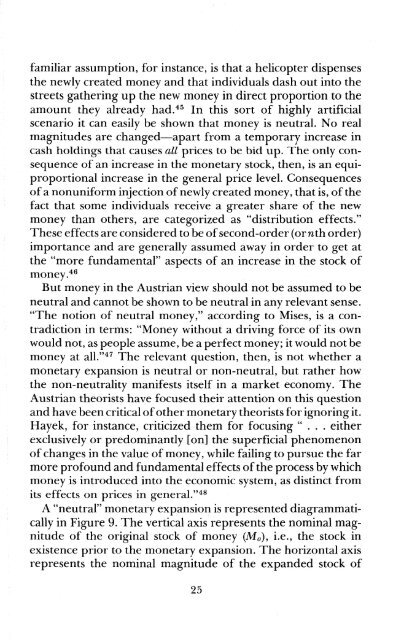Austrian Macroeconomics - Ludwig von Mises Institute
Austrian Macroeconomics - Ludwig von Mises Institute
Austrian Macroeconomics - Ludwig von Mises Institute
Create successful ePaper yourself
Turn your PDF publications into a flip-book with our unique Google optimized e-Paper software.
familiar assumption, for instance, is that a helicopter dispenses<br />
the newly created money and that individuals dash out into the<br />
streets gathering up the new money in direct proportion to the<br />
amount they already had. 45 In this sort of highly artificial<br />
scenario it can easily be shown that money is neutral. No real<br />
magnitudes are changed-apart from a temporary increase in<br />
cash holdings that causes all prices to be bid up. The only consequence<br />
of an increase in the monetary stock, then, is an equiproportional<br />
increase in the general price level. Consequences<br />
ofa nonuniform injection ofnewly created money, that is, ofthe<br />
fact that some individuals receive a greater share of the new<br />
money than others, are categorized as "distribution effects."<br />
These effects are considered to be ofsecond-order (orn th order)<br />
importance and are generally assumed away in order to get at<br />
the "more fundamental" aspects of an increase in the stock of<br />
money.46<br />
But money in the <strong>Austrian</strong> view should not be assumed to be<br />
neutral and cannot be shown to be neutral in any relevant sense.<br />
"The notion of neutral money," according to <strong>Mises</strong>, is a contradiction<br />
in terms: "Money without a driving force of its own<br />
would not, as people assume, be a perfect money; it would not be<br />
money at all."47 The relevant question, then, is not whether a<br />
monetary expansion is neutral or non-neutral, but rather how<br />
the non-neutrality manifests itself in a market economy. The<br />
<strong>Austrian</strong> theorists have focused their attention on this question<br />
and have been critical ofother monetary theorists for ignoring it.<br />
Hayek, for instance, criticized them for focusing " . . . either<br />
exclusively or predominantly [on] the superficial phenomenon<br />
ofchanges in the value of money, while failing to pursue the far<br />
more profound and fundamental effects ofthe process by which<br />
money is introduced into the economic system, as distinct from<br />
its effects on prices in general."48<br />
A "neutral" monetary expansion is represented diagrammatically<br />
in Figure 9. The vertical axis represents the nominal magnitude<br />
of the original stock of money (Mo) , i.e., the stock in<br />
existence prior to the monetary expansion. The horizontal axis<br />
represents the nominal magnitude of the expanded stock of<br />
25

















